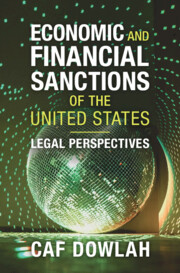Book contents
- Economic and Financial Sanctions of the United States
- Economic and Financial Sanctions of the United States
- Copyright page
- Dedication
- Contents
- Figures
- Tables
- Preface
- Table of Cases
- Table of Statutes and Regulations
- Conventions, Treaties, and Resolutions
- Presidential Executive Orders
- Abbreviations
- 1 Overview of Economic and Financial Sanctions
- 2 Economic and Financial Sanctions under International Law
- 3 Legal Frameworks of US Economic and Financial Sanctions
- 4 Enforcement Infrastructures of US Economic and Financial Sanctions
- 5 US Economic and Financial Sanctions against the Russian Federation
- 6 US Economic and Financial Sanctions against the Islamic Republic of Iran
- 7 US and Multilateral Sanctions Regimes against the Republic of Iraq
- 8 US Economic and Financial Sanctions against the Republic of Cuba
- 9 US Economic and Financial Sanctions against the Bolivarian Republic of Venezuela
- Index
- References
6 - US Economic and Financial Sanctions against the Islamic Republic of Iran
Published online by Cambridge University Press: 22 March 2025
- Economic and Financial Sanctions of the United States
- Economic and Financial Sanctions of the United States
- Copyright page
- Dedication
- Contents
- Figures
- Tables
- Preface
- Table of Cases
- Table of Statutes and Regulations
- Conventions, Treaties, and Resolutions
- Presidential Executive Orders
- Abbreviations
- 1 Overview of Economic and Financial Sanctions
- 2 Economic and Financial Sanctions under International Law
- 3 Legal Frameworks of US Economic and Financial Sanctions
- 4 Enforcement Infrastructures of US Economic and Financial Sanctions
- 5 US Economic and Financial Sanctions against the Russian Federation
- 6 US Economic and Financial Sanctions against the Islamic Republic of Iran
- 7 US and Multilateral Sanctions Regimes against the Republic of Iraq
- 8 US Economic and Financial Sanctions against the Republic of Cuba
- 9 US Economic and Financial Sanctions against the Bolivarian Republic of Venezuela
- Index
- References
Summary
This chapter delves into the intricate saga of Iran – a Middle Eastern country – under US economic and financial sanctions initiated in 1979 and periodically renewed due to Iran’s nuclear aspirations. The chapter traces historical events from the Tehran Hostage Crisis to the post-Khomeini era, shaping US–Iran dynamics across administrations. It covers the JCPOA of 2015, the Trump Administration’s withdrawal, and re-imposition of sanctions. The legal dimensions of unilateral and multilateral sanctions are explored, presenting diverse perspectives on their complexities within international law. Examining repercussions, the chapter scrutinizes their effects on Iran’s economy and populace under economic blockade over the decades.
Keywords
- Type
- Chapter
- Information
- Economic and Financial Sanctions of the United StatesLegal Perspectives, pp. 196 - 233Publisher: Cambridge University PressPrint publication year: 2025

